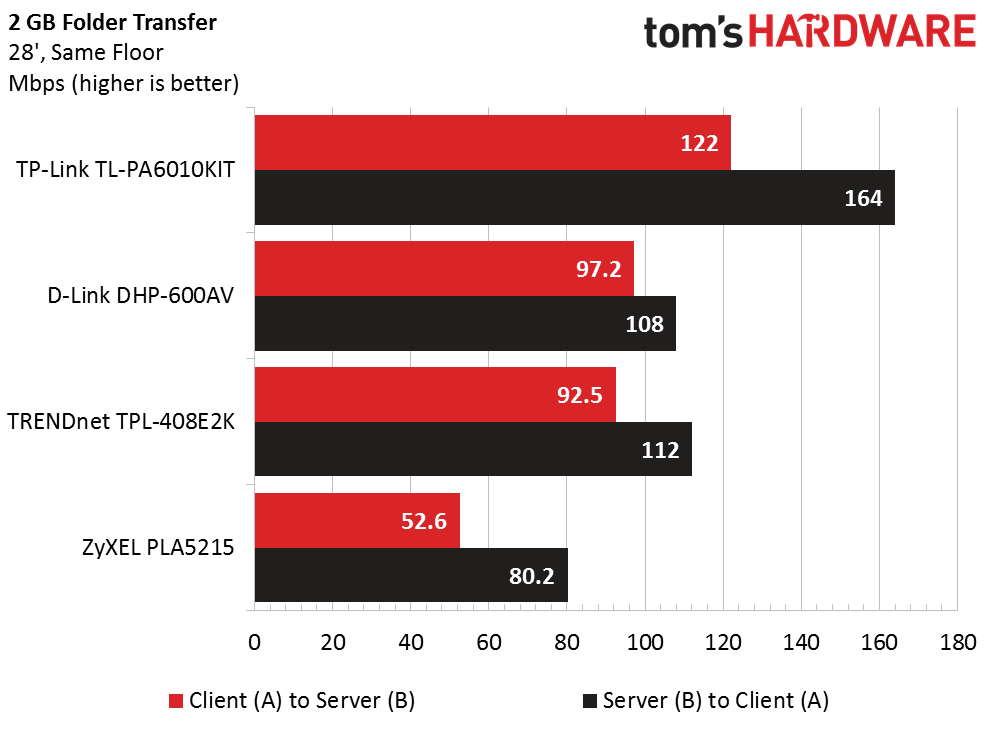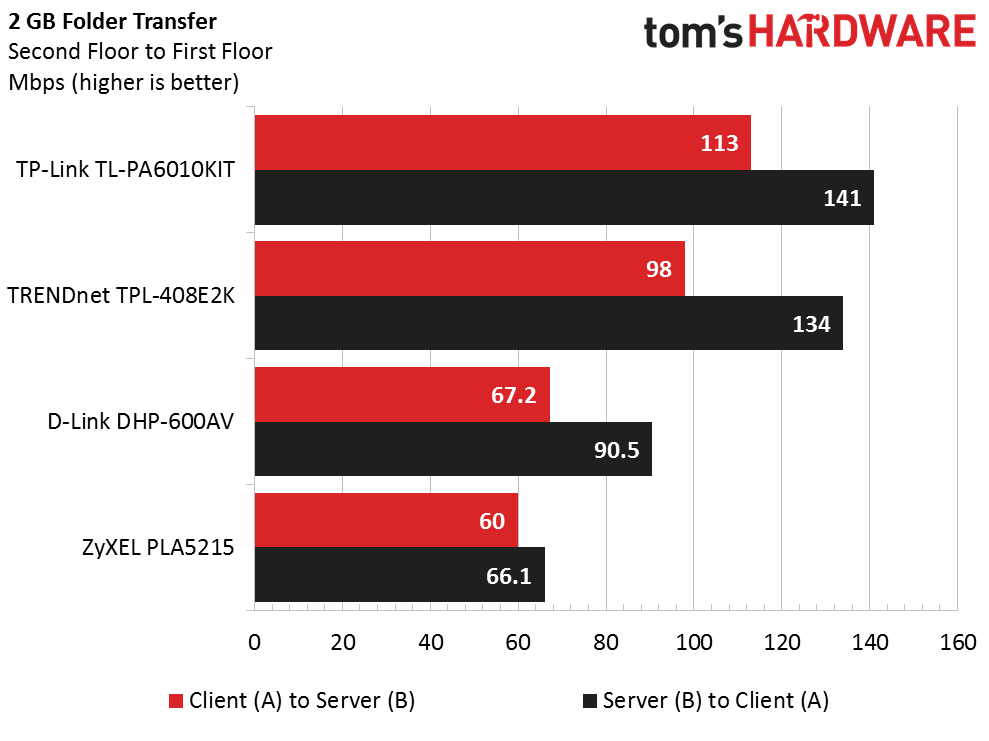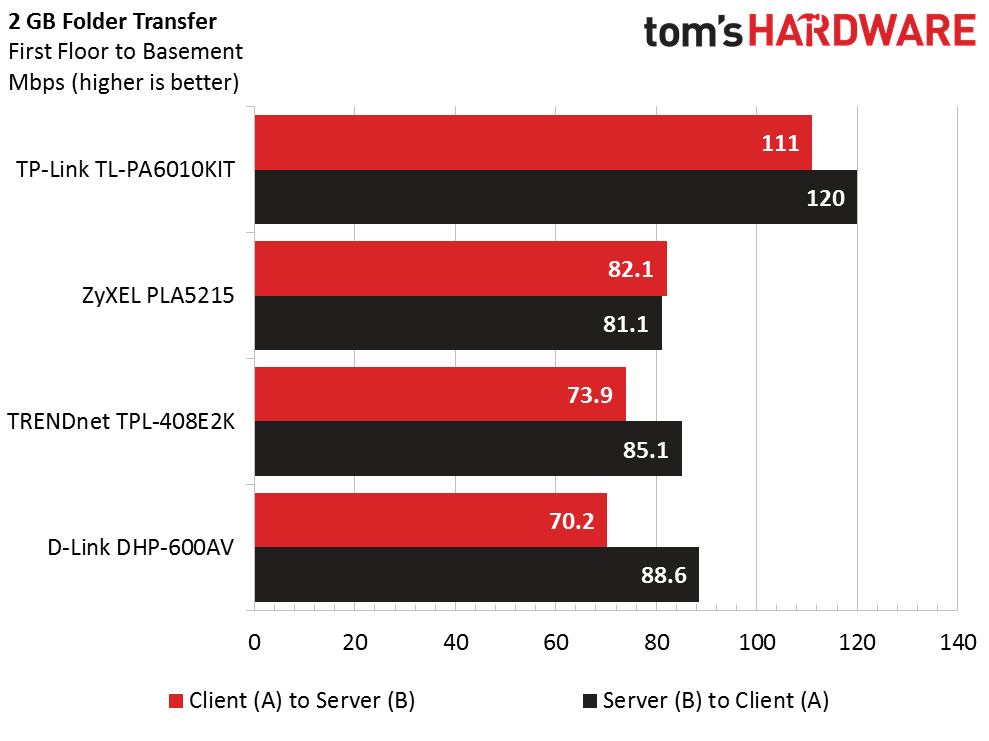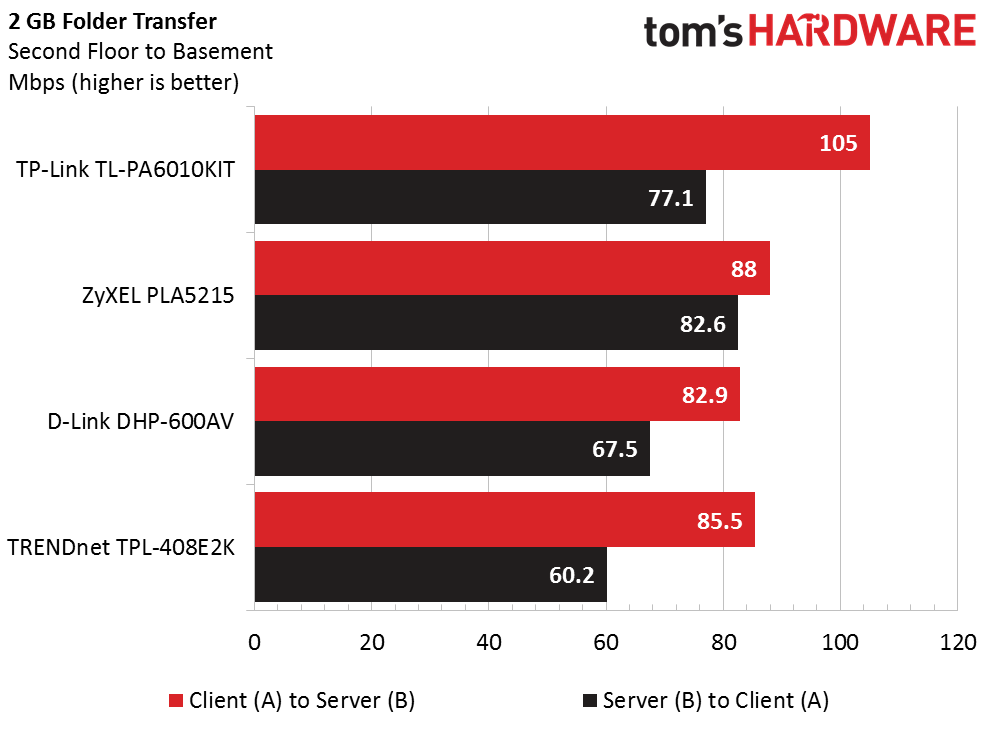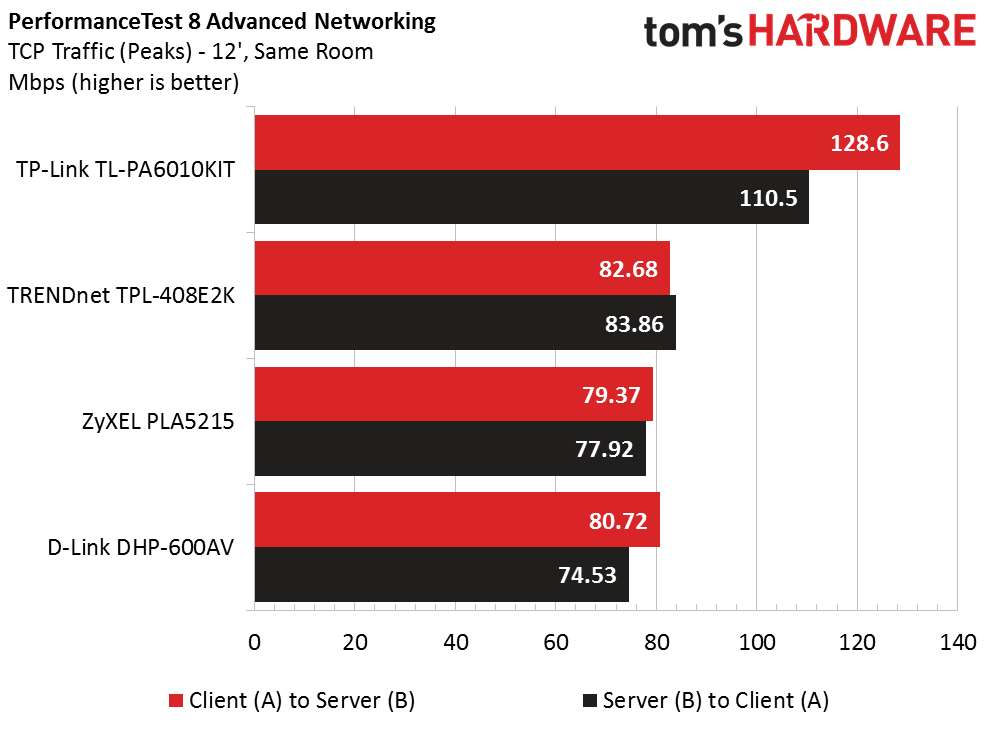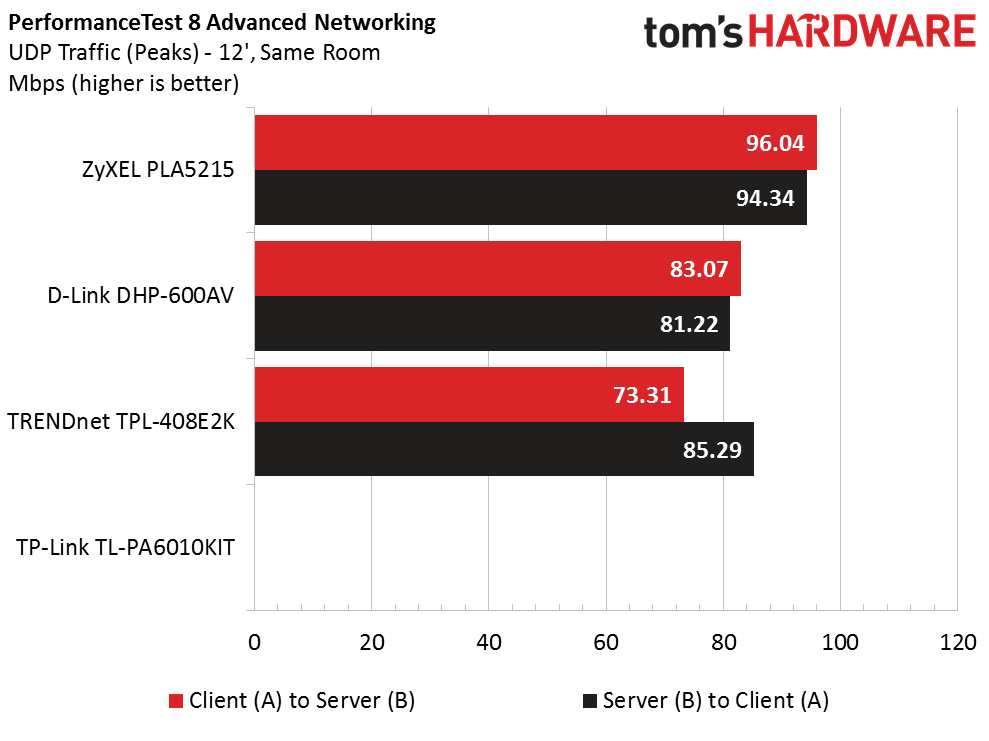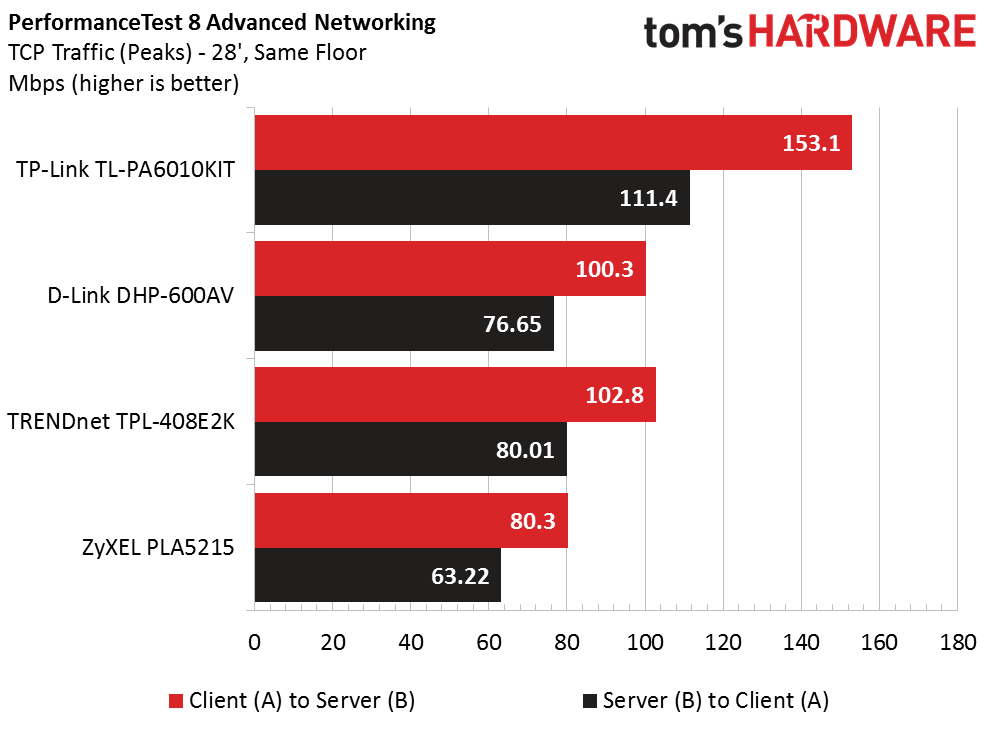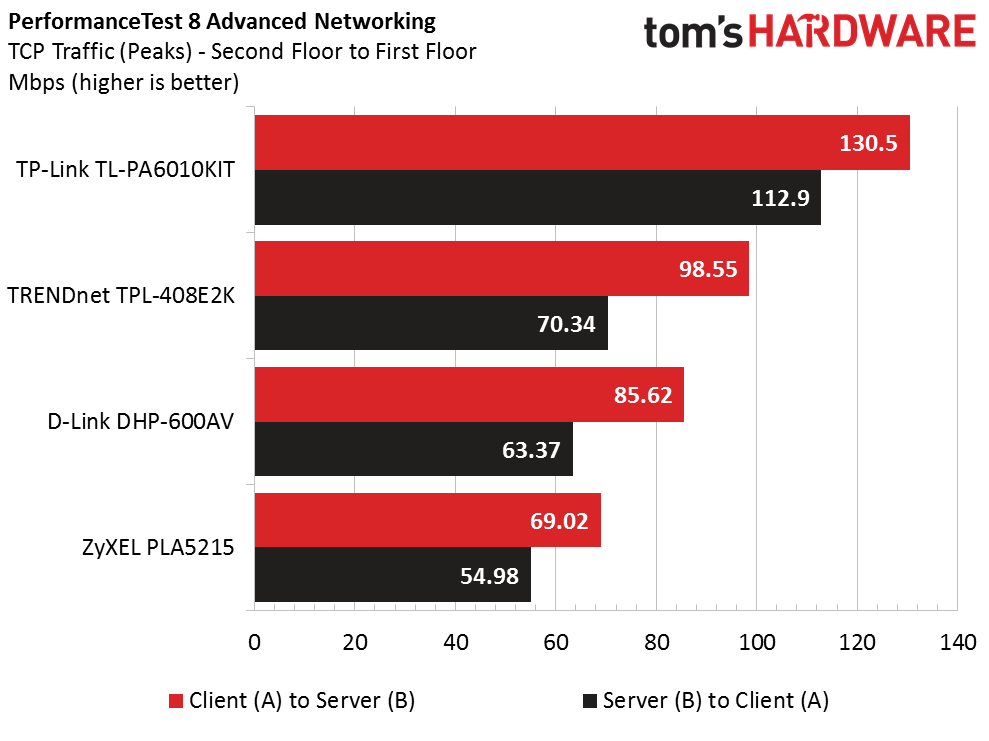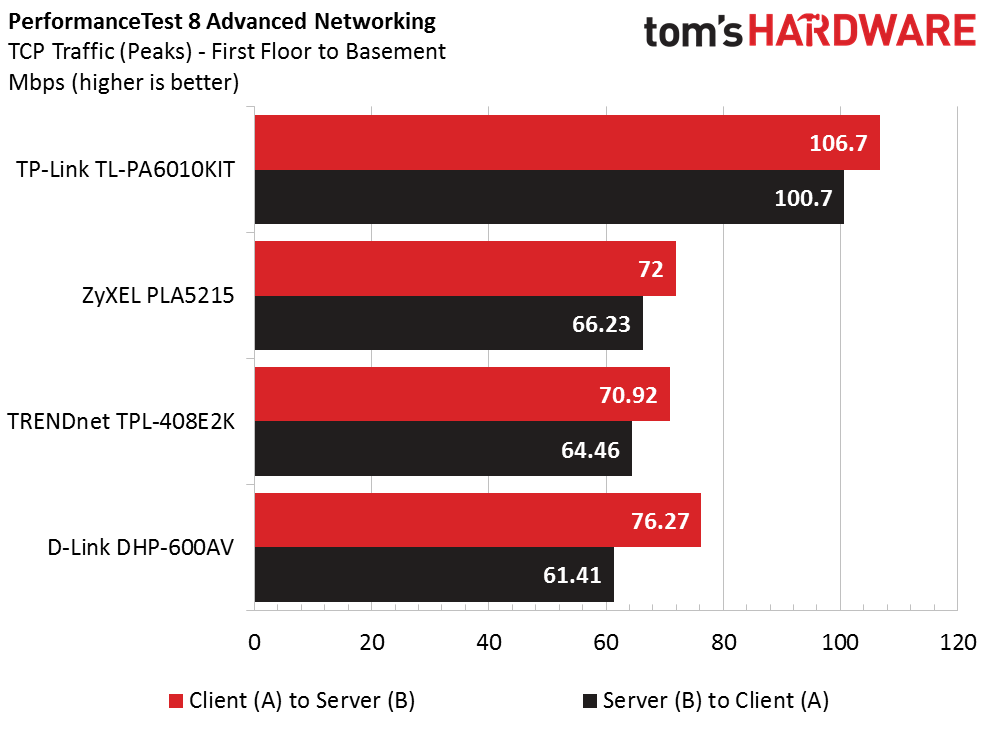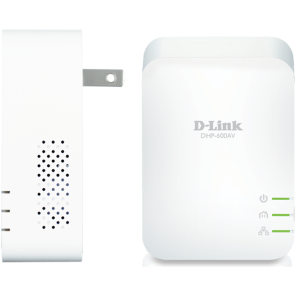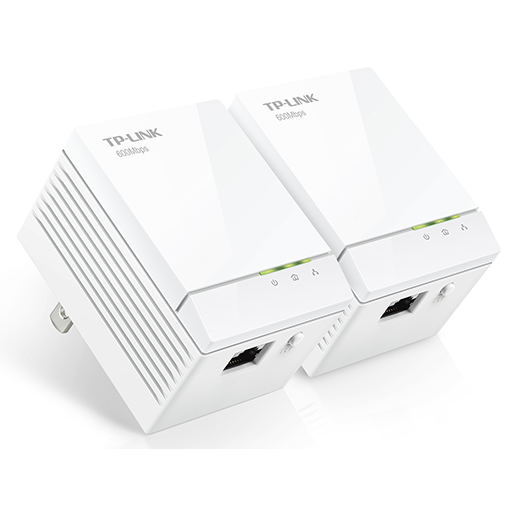HomePlug AV2 Powerline Networking Adapter Round-Up
Powerline technology can help augment the demands placed on your existing Wi-Fi network, but at what speeds? We tested four powerline adapters to find out.
Test Results
Why you can trust Tom's Hardware
2GB Folder Copy Tests
Remember that these numbers are the peak values observed. Obtaining averages was difficult using the Networx software since the test didn't automatically stop calculating once the transfer ceased. In other words, after the folder copy finished, every second after dropped the average transfer rate.
Keeping this in mind, you'll notice that the TP-Link TL-PA6010 kit performed best in the same-room measurement, in either direction, by almost 28 percent. We have a tight middle grouping between ZyXEL and Trendnet, as D-Link's DHP-600AV edges out the rest of the pack by almost six percent.
Moving the powerline adapters farther away from each other seems to improve the transmission rate in some cases, while clearly affecting others negatively. As to what factors influence the outcome, read our How We Test article to see how difficult it is to answer that question.
We can at least see that the same hardware ends up on top. The TP-Link powerline adapters again pull in the lead position, while D-Link retains its second-place standing. Below those two, there's some shuffling in finishing order, as ZyXEL drops to last place.
Moving the remote powerline adapters to the second floor, TP-Link retains its lead while Trendnet continues its upward trajectory, displacing D-Link for second place. ZyXEL retains its standing from the Same Floor test.
Once again, TP-Link leads the pack. But we have a shift for second place as ZyXEL zooms ahead of the rest and kicks Trendnet out of second place, knocking everyone else down a peg.
In the longest linear distance test, TP-Link refuses to give up its lead, and ZyXEL maintains a second-place spot.
Performance Test 8 Results
This first set of results again compares peak values, as measured by the PerformanceTest 8's Advanced Networking Test. What I like about PerformanceTest 8 is its more static recording of the averages once the benchmark completes. So, let's cover the peak values above for our Same Room test and pit them against the average values below.
When it comes to measuring throughput, I'm always interested in the averages as well as the peaks because I want to know how well speed is maintained over time. Fortunately, it appears in all cases that differences are not drastic, although the averages are naturally lower. We also observe that the averages don't change our rankings: TP-Link finishes in first place again. Interestingly, though, Trendnet and D-Link swap places, according to PerformanceTest 8.
Next up, we have UDP (User Datagram Protocol).
The above chart clearly requires explanation. For the adapter with no score, when I tested their UDP throughput, the stats on the client side claimed throughput was reaching upward of 300 Mb/s. However, when I verified those figures on the server side, throughput was much lower due to packet loss. That same condition occurs when you flood a switch with UDP packets, as it overwhelms the receiving device's capacity to keep pace with the traffic. Out of those adapters that didn't flood the receiving device, ZyXEL wins out, followed by D-Link and Trendnet.
Our Same Floor test reflects the same rankings as those found in our 2GB folder copy benchmark. Mainly, TP-Link finishes in the lead.
The top three products maintain the same standings in this test as on the previous page.
Based on the First Floor to Basement test above and the Second Floor to Basement test below, ZyXEL seems to perform better using wiring on the outer walls of the house.
Get Tom's Hardware's best news and in-depth reviews, straight to your inbox.
-
Glock24 I'm curious about device interoperability. If all those devices you tested conform to the same standard, can you mix and match those devices in the same network?Reply -
heffeque ReplyI'm curious about device interoperability. If all those devices you tested conform to the same standard, can you mix and match those devices in the same network?
Almost no PLC will work with other brands... and most won't even work between different versions of the same brand. -
joex444 On your conclusions page you link to an article that Tom's did in 2009 and claim the test result showed powerline adapters that failed to get 10Mb/s. In fact that link shows adapters that failed to get 10MB/s -- a factor of 8 higher due to your units error. The lowest rate in 2009 was 20Mb/s and many were in the 50-80Mb/s.Reply -
aldenf Good article. Thanks, Matthew!Reply
I read the linear 300m range, for the DHP-600AV anyway, as the maximum length of electrical wiring between adapters, not the allowable length of CAT twixt an adapter and device.
Powerline networking has had ample opportunity to mature. If it can't sustain 200Mbps, it is of little use to me or my clients. Scenario: Someone wants an Ethernet drop in three rooms of his house. That's $300 in hardware alone... Does the hardware for multiple drops of Ethernet interfere with each other and how badly? I can only imagine that in extreme cases, where CAT5e/6 can't reasonably be run, would this even be an option. Too bad, really... -
chalabam ReplyI'm curious about device interoperability. If all those devices you tested conform to the same standard, can you mix and match those devices in the same network?
Almost no PLC will work with other brands... and most won't even work between different versions of the same brand.
That's the point of the standards, to assure that each device is compatible with one of another vendor.
If a device doesn't works with another, it doesn't works with the standard.
A specific model will never be the best for ever. You will replace it with the future best one, and you don't want to replace all, or throw the present one to the garbage because they can't communicate with each other.
-
heffeque Reply
Well this isn't the case. The fact is that they don't operate well when not paired up with equals, so what do you propose.16653190 said:I'm curious about device interoperability. If all those devices you tested conform to the same standard, can you mix and match those devices in the same network?
Almost no PLC will work with other brands... and most won't even work between different versions of the same brand.
That's the point of the standards, to assure that each device is compatible with one of another vendor.
If a device doesn't works with another, it doesn't works with the standard.
A specific model will never be the best for ever. You will replace it with the future best one, and you don't want to replace all, or throw the present one to the garbage because they can't communicate with each other. -
RealBeast The newest models (AV1200 with MIMO) get about twice the speed of these older units that you tested. I've tried three sets based on solid reviews and they have all performed quite well. The are a little more expensive and still nowhere near gigabit Ethernet, but all three got over 200Mbps on distant plugs, with the TP-LINK TL-PA8030P-KIT at $70 on Amazon hitting over 250Mbps consistently with low latency, IMO quite usable particularly for gamers.Reply -
dragget ReplyThe newest models (AV1200 with MIMO) get about twice the speed of these older units that you tested.
I find it really puzzling that they would review these older, slower devices instead of the new MIMO models. Several manufacturers have had these newer models out on the market for some time now.
-
jmaier Extollo's LANSocket 1500 seems to be the fastest on the market today. See articles from CNET: http://www.cnet.com/products/extollo-lansocket-1500-powerline-adapter-kit/ and TechHive: http://www.techhive.com/article/2981494/home-networking/extollo-communications-lansocket-1500-review-top-speed-and-a-power-passthrough-too.htmlReply
It's based on the HomePlug AV2 standard and supports MIMO, it's using the latest powerline chips from Broadcom. It's a pass-through and a bit bulky. I believe the bigger size is needed for the multiple transmitters and receivers to support MIMO. Extollo has one of the best product manuals, it provides a fairly succinct overview of HomePlug's powerline networking concepts.
Matthew Matchen, how did you omit the LANSocket 1500 powerline adapter from your list of adapters to test?
-
matchenm Hi joex444,Reply
On your conclusions page you link to an article that Tom's did in 2009 and claim the test result showed powerline adapters that failed to get 10Mb/s. In fact that link shows adapters that failed to get 10MB/s -- a factor of 8 higher due to your units error. The lowest rate in 2009 was 20Mb/s and many were in the 50-80Mb/s.
Great catch! You're right that I need to correct that comparison. Hope to get that updated soon.

